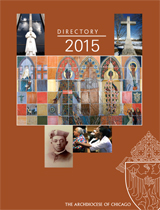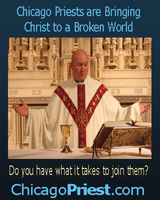May 25, 2008
Christ’s death is ‘re-presented’ through the Eucharist
The Second Vatican Council declared that taking part in the Eucharistic sacrifice (Mass) is the “source and summit” of the whole Christian life. Further, the council documents teach that through the action of the Eucharist human beings offer Jesus, who is the Divine Victim, to God along with themselves.
In making this declaration, the council cited a sentence from John’s Gospel that implies that the Eucharist is meant to strengthen and make real our relationship with God. “And when I am lifted up from the earth, I will draw everyone to myself” (Jn 12:32).
Jesus, in obedience to the Father’s will, accepted the mission of reconciling the world to himself by breaking the isolation from God that sin had caused. The isolation led to death, but through Jesus, who taught that he is “the way the truth and the life” (Jn 14:6), life in God had been restored.
The restoration of life from the darkness of sin was made possible through the sacrifice of the cross, whereby Jesus gave his total self in love for humanity. The sacrifice of the cross is made timeless and ever present through the sacrament of the Eucharist, wherein the act of Jesus’ total self-giving is made present in a substantial way in each Mass and for every generation continuing until the end of time.
The Eucharist then becomes the means by which Jesus continues intimately to relate to his bride, which is the church. The relationship that Jesus has with his bride through the Eucharist significantly makes present the reality that the head of the body (Jesus) is united with her faithful members who make up the church.
In his encyclical, “Ecclesia de Eucharistia” Pope John Paul II connects the Eucharist with Christ’s spousal love of his bride the church. He writes, “Christ’s spousal and redemptive love continuously given to his bride the church is made present in the Eucharist and is ‘the gift par excellence,’ for it is the gift of himself, of his person in sacred humanity, as well as the gift of his saving work.”
More recently, Pope Benedict XVI spoke about the spousal nature of the Eucharist by connecting this sacrament with that of the sacrament of marriage. He explained that there is a profound bond between the two sacraments. In their daily lives, the pope preached, couples must draw inspiration for their behavior from the example of Christ who “loved the Church and gave himself up for her.”
Offering the divine
On the night before he died, Jesus took bread and wine and said, “This is my Body, this is my Blood.” After saying those sacred words, he concluded by saying, “Do this in memory of me.” The apostles who witnessed the Last Supper were unaware that Jesus was instituting the Eucharist, and moreover were oblivious that this action would be inextricably connected with the following day, his death on the cross.
The Catechism of the Catholic Church instructs us that, “The sacrifice of Christ and the sacrifice of the Eucharist are one single sacrifice.” Often, this doctrine of a single sacrifice is explained by using the term, “re-presented.” The sacrifice on Calvary is re-presented through the ministry of the priests, the same sacrifice but the manner of offering is different.
The Eucharist makes present the sacrifice of the cross — once bloody, it is now made on the altar in an un-bloody way. At this point we may be struck with a quandary. We might ask, was not Christ’s death the offering to the Father once and for all? Indeed, his death was once for all and completely adequate for our redemption. However, Jesus himself instructed his apostles to continue the act of sacrifice in memory of him.
The words of Christ himself point to a reality that the sacrifice of the cross must be perpetuated throughout time. The reason is that the sacrifice of love is made visible to each age and the power derived from it forgives our daily failings due to our human weakness.
Offering ourselves to God
Christ sacrifice is first and foremost offered to the Father. A gift to the Father is accepted for our sake by the total selfgiving of the son. The sacrifice of the Son is given on behalf of his bride the church, which in turn offers the Son to the Father along with the united sacrifice of the members of the body.
Through the reception of the Eucharist, members of the church unite with her head (Jesus) through their offerings, which are acceptable to the Father. The Catechism states, “The Eucharist is also a sacrifice of the Church. The church which is the Body of Christ participates in the offering of the head. With him, she herself, is offered whole and entire.” Further, “In the Eucharist, the sacrifice of Christ becomes also the sacrifice of the members of his body.”
Signifying unity
The generous gift of Christ in the Eucharist signifies the intimate means by which human beings can participate in a real substantial way in the life of God. Before Adam and Eve sinned, humanity was intimately connected with God by the very gift of his creation. By the redemptive act of God, humanity was again connected with the source of life.
The “gift” of our relationship with God is expressed in the Eucharist, whereby the intimacy of Creator and creature is once again restored. John Paul II explains this relationship beautifully, “We can not only say that each of us receives Christ, but also that Christ receives us.”
What can be a greater mutual expression of love, whereby two fleshes become one? The church members are not many bodies, but one body in Christ. Just as bread is completely one although it is made up of many grains, they nonetheless retain their individuality.
Through the reception of the Eucharist the communion of humanity and God ensures that humanity is already sharing eternal life, possessing it here on earth as the first fruits that will embrace humanity for eternity.
“And when I am lifted up from the earth, I will draw everyone to myself.”
Fiala is with the John Paul II Newman Center at the University of Illinois-Circle Campus.
Get to know the Eucharist better
When we think of what it means to be Catholic, often the thing that comes to mind is the Eucharist. It’s also one of the most difficult sacraments to explain because there is so much depth and meaning wrapped up in it. But there is no shortage of available books, resources, web sites and more out there to help us understand it better. Here are some books that can help enhance your understanding of the sacrament of the Eucharist:
- Catechism of the Catholic Church
- “Ecclesia de Eucharistia” (On the Eucharist in Its Relationship to the Church), by Pope John Paul II
- “God Is Near Us: The Eucharist, the Heart of Life,” by Cardinal Joseph Ratzinger
- “A Key to the Doctrine of the Eucharist,” by Abbot Vonier, Peter Kreeft and Aidan Nichols
- “This Is My Body: Eucharistic Reflections Inspired by Adoro Te Devote and Ave Verum,” By Raniero Cantalamessa, O.F.M. Cap.
- (For kids) “The Holy Eucharist Coloring & Activity Book,” written and illustrated by Virginia Helen Richards, FSP and D. Thomas Halpin, FSP
 Catholic
New World - Newspaper for the Archdiocese of Chicago
Catholic
New World - Newspaper for the Archdiocese of Chicago Archdiocese of Chicago Directory
Archdiocese of Chicago Directory Oficjalne wydawnictwo Archidiecezji Chicago w języku polskim
Oficjalne wydawnictwo Archidiecezji Chicago w języku polskim